Posts Tagged: blackberries
Fresh Market Blackberry Cost and Return Study Now Available from UC Cooperative Extension
The new edition of "Sample Costs to Establish and Produce Fresh Market Blackberries Study" is now available from UCCE.
http://coststudies.ucdavis.edu/files//2013/09/30/blackberrycc2013.pdf
This is another great cost and return study in berries authored by Laura Tourte, Rich De Moura, Karen Klonsky, and yours truly.
We certainly weren't in alone in writing this study, and this work could not have been accomplished without the substantial input and contributions from local blackberry growers - thank you all!
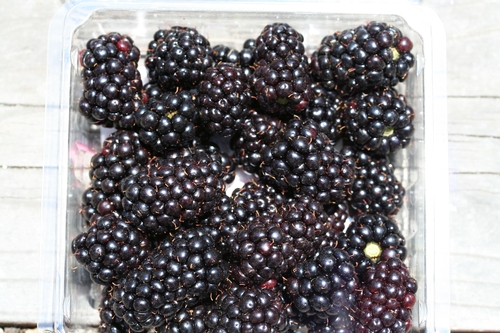
2013 Cost and Return Study now available for fresh market blackberries on the Central Coast.
Understanding Chill for Berries in California
The cold weather we have been experiencing over the past few days has prompted a lot of talk and even articles in the popular press over what the effect of this cold would be to local berry growers. Beyond the damage that very cold temperatures could cause tender plant parts such as flowers and emerging vegetative parts (of which we fortunately don’t have very many right now), the question worth exploring is what benefit this weather could be bringing to our berry crops.
Many of our cultivated fruiting plants originate from temperate regions, including many berry species and tree fruits, and as such go dormant in response to oncoming cold weather in the autumn. This adaptation of dormancy protects the plant buds from injury when temperatures fall below freezing and the buds stay this way until enough cold has been accumulated over time.
This accumulation of cold over time, known as chilling requirement and measured in hours as chill units, is the minimum amount of cold after which many fruit trees, caneberries and strawberries need to be exposed to in order to grow properly in the following spring. The total number of hours of chill needed to establish proper flowering and vegetative growth vary substantially for plant types and even between varieties of the same plant species.
If plants requiring a certain amount of chill hours do not receive it, they may end up blooming or leafing out late in the spring or in an spread out, uneven fashion. Additionally, they may subsequently experience reduced fruit production and quality.
Another complication of calculating chill units in California, as compared to much colder regions of the country, for example Wisconsin where temperatures can be below freezing for weeks at a time (go Badgers!), is that our region tends to have a cycling of warm and cold weather throughout the winter. How then do we as agriculturalists in California calculate chill accumulation in this back and forth between cold and warm?
To calculate chill hours, there are three common models all based on the principle that plants accumulate chill between 45 degrees F and freezing (32 degrees F and not below). One model ignores the below freezing threshold and simply calculates total number of hours under 45 degrees F, another calculates number of hours between 32 degrees and 45 degrees, and another, called the Utah model, is bounded by 34 degrees and 45 degrees but also accounts for negative chill accumulation, being the understanding that temperatures above 61 degrees detract from chill hours already accumulated. It is worth pointing out that in the Utah model, temperatures under 34 degrees do not accumulate chill, nor do they detract from it.
Yet, the fluctuating temperatures of California still are a challenge to some degree for these models, and the University of California is engaged in research to get a better handle on these conditions, and is has been testing a “Dynamic Chill Model” and a “Chill Portion Model”. Both of these are beyond the scope of this blog, but Central Coast agriculturalists seeking to further their understanding about chill and how to manage it, will find an excellent resource at :
http://fruitsandnuts.ucdavis.edu/Weather_Services/chilling_accumulation_models/
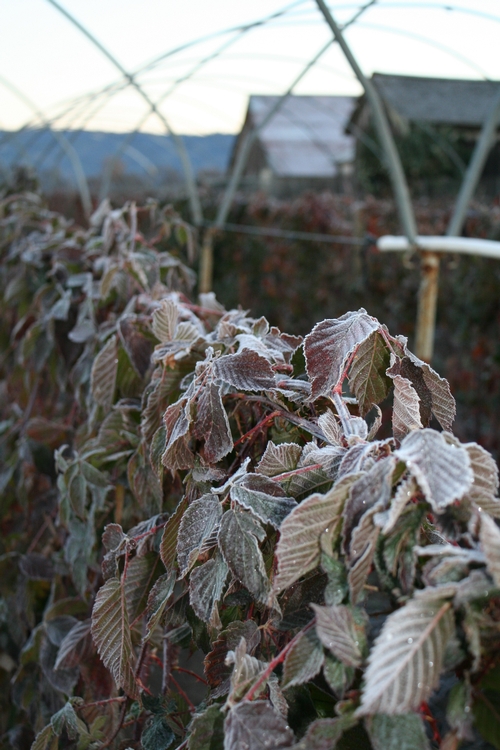
7:15 am, January 13, 2013. Temperature 25 degrees F. Good morning Watsonville!
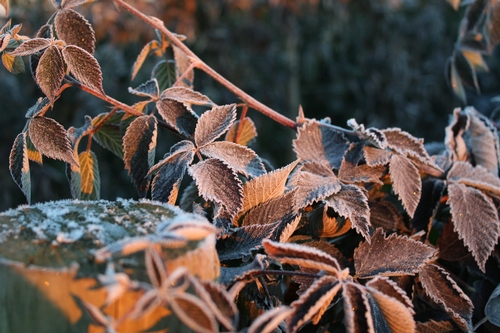
Blackberry leaves covered in frost - plus or minus benefit to the plant?
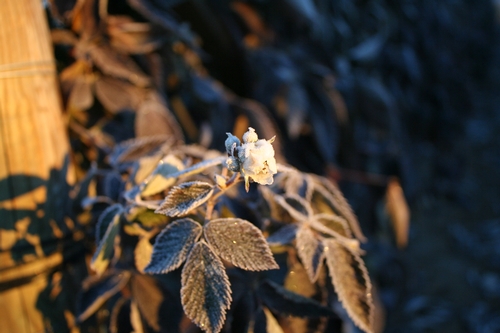
This frost covered blackberry flower will unfortunately not make it to fruiting.
A Treatise on Botrytis Diseases of Strawberry and Caneberry
Introduction: A major purpose of this blog is to educate and inform on new emerging issues and developments in strawberries and caneberries. In addition, we also want to review and update common, well known issues that readers may be very familiar with. The following article is a review of a very important disease affecting the strawberry and caneberry industries: gray mold caused by Botrytis cinerea.
Causal Organism: Botrytis cinerea belongs to the fungal phylum Deuteromycota (sometimes also known as fungi imperfecti) and reproduces by forming asexual spores (conidia). The sexually reproducing stage has not been seen on strawberry or caneberry. The young mycelium of this fungus is septate, branched, and basically colorless. When this fungus is grown on potato dextrose agar, a common medium used to culture fungi, Botrytis cinerea is at first white and later turns gray as spores form. The spore producing structures are branched, up to 5 mm tall, and light to dark gray in color. Even under the low magnification of a dissecting microscope, one can readily see the distinctive “botryose” (Greek for bunch of grapes) clusters of spores at the ends of the spore-bearing branches (see sixth picture below).
Symptoms on Fruit: The rot from Botrytis is fairly simple to distinguish from the other fruit rots occurring in strawberries and caneberries. Generally, Botrytis rot will start as a light brown to gray spot (see third photo below) without any distinct margin around the affected area. This spot remains firm as it spreads and even a fruit completely rotten with Botrytis will retain its original shape. After a few days, if conditions are favorable (temperatures between 59o- 77oF), a brown to gray velvety growth will appear on the surface of the infected fruit.
Disease Cycle: Botrytis fruit infections on the Central Coast generally begin when the spore lands on the strawberry or caneberry flower. Given cooler temperatures and the presence of water, the spore germinates and infects the flower. If conditions are really favorable, the disease will progress in flower tissues and result in blighted blossoms that will no longer develop into fruit. Partial flower infections can cause brown lesions to form on the fruit receptacle; such flowers will not produce normal, fully developed fruit. In other cases the flower-invading Botrytis can become dormant and will not resume growing until fruit sugar content is more amenable for growth, at which point the disease will become evident from the brown lesion and subsequent gray velvety growth that occurs on the ripening fruit. If conditions become unfavorable for further disease development, Botrytis growth will stop and the lesion will become dry and leathery.
Because Botrytis is an aggressive colonizer of plant wounds, direct infection of the fruit can also occur if the fruit is injured from physical abrasion (rubbing caused by winds, for example), insect feeding, environmental extremes, other diseases, and other factors. Mature, ripe fruit are especially susceptible to infection because of their high sugar content and sensitive tissues. For this reason, Botrytis is an important component of post-harvest fruit losses.
Epidemiology: Botrytis spores (primary inoculum) are everywhere. The fungus grows well on senescent, dead tissues (old, dead strawberry stems and leaves; crop residues of other adjacent crops). Spores are blown by winds or splashed by rains onto flower and fruit tissues. It is important to note that the presence of free moisture for several consecutive hours is necessary for spore germination. Therefore, development of gray mold disease is greatest in cool and wet conditions, such as rain and the fog commonly experienced here on the Central Coast.
Control: Growers and managers should take a threefold approach to managing Botrytis gray mold in the field.
Fungicides: There is a substantial universe of fungicides available for the management of gray mold in strawberries and caneberries and a decent listing of these materials is available at the UC IPM website (http://www.ipm.ucdavis.edu/PMG/crops-agriculture.html). The key point for disease managers is to apply fungicides BEFORE major moisture events. As emphasized above, Botrytis spores need free moisture to germinate; therefore fungicides, which mostly act as protectants,should be in place before the occurrence of humidity and free moisture from rain or heavy fog . It is worth noting that the use of surfactants, which serve to better distribute fungicides over the plant surface as well as stabilize them, is strongly recommended with fungicide applications.
Sanitation: Removal of infected fruit from around the plant during the harvest season is helpful in reducing Botrytis gray mold potential, since each infected fruit produces millions of spores that can move onto nearby flowers and fruit. It is not necessary to remove fruit completely from the field; deposition of diseased fruit into the furrow and its periodic destruction by foot or machine traffic is sufficient. Additionally, removal of dead leaves on occasion can be of benefit because it removes another potential source of inoculum while at the same time maintaining more air circulation around the plant and keeping it drier.
Moisture management: Knowing that free moisture is critical to development of Botrytis grey mold gives managers a key tool in limiting development of this disease. For strawberries, planting so as to account for expected plant size and allowing for more air circulation is one step. It is worth noting that transplants can be chilled with an eye to managing plant size; short day varieties such as Chandler and Camarosa should not be chilled more than three days for most situations, and day neutral varieties such as Albion, San Andreas or Monterey generally should not be chilled more than 18 days. The use of drip irrigation, a universal practice in California, is essential for preventing irrigation water from contributing to favorable conditions for gray mold disease.
The use of macro-tunnels (also called high tunnels or Spanish tunnels) in caneberries results in a tremendous reduction of free moisture from rain or dew and a very real drop in the amount of gray mold disease to the extent that fungicide applications for Botrytis might be dispensed with entirely. There is no bigger step a caneberry grower can take to reduce Botrytis gray mold in their crop than to construct a macro-tunnel over it.
Before using any fungicide products, check with your local Agricultural Commissioner's Office and consult product labels for current status of product registration, restrictions, and use information.
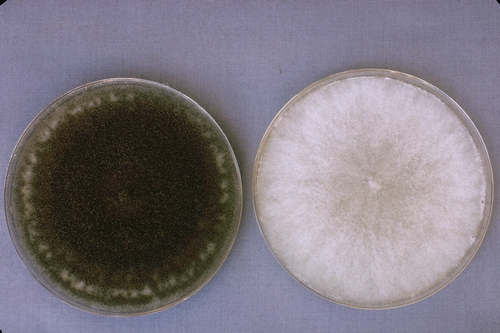
Botrytis cultures grown with light (left) and in complete darkness (right). Photo courtesy Steven Koike, UCCE
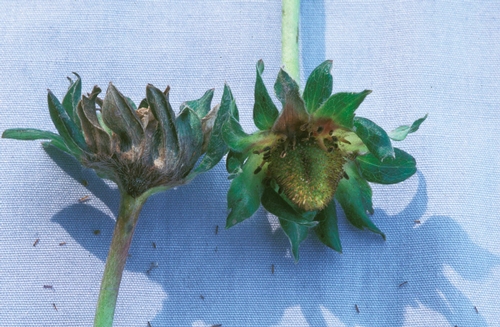
Gray mold lesions on calyces of developing fruit. Photo courtesy Steven Koike, UCCE.
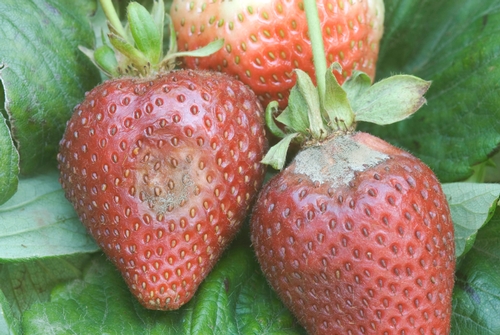
Early gray mold lesion on strawberry fruit. Photo courtesy Steven Koike, UCCE.
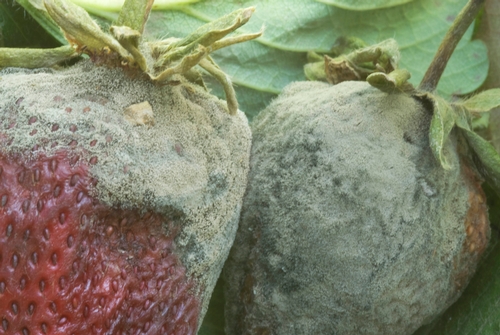
Extensive Botrytis sporulation on advanced gray mold of strawberry fruit. Photo courtesy Steven Koike, UCCE.
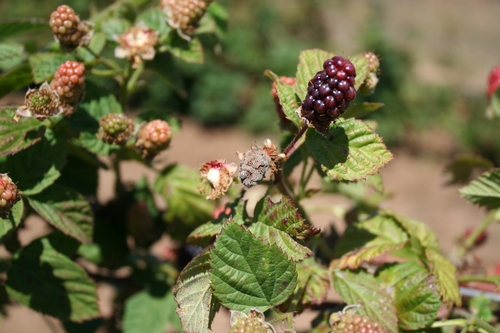
Botrytis infection on blackberry fruit. Fruit is desiccated and dried out. Photo Mark Bolda, UCCE Santa Cruz County.
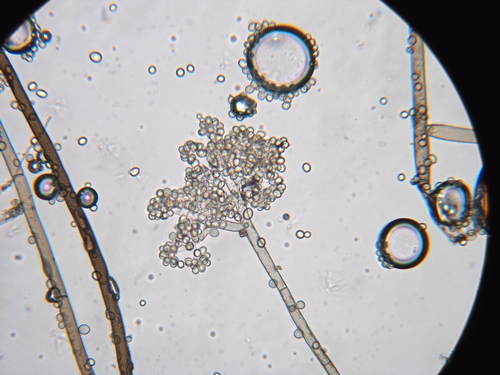
Clustered spores of Botrytis cinerea. Photo courtesy Steven Koike, UCCE.
UCCE Fresh Market Caneberry Manual Now Available
University of California Cooperative Extension proudly presents the Fresh Market Caneberry Manual. Written for California and West coast fresh market caneberry growers by UCCE caneberry experts Mark Bolda and Mark Gaskell, along with extremely valuable contributions from Michael Cahn on irrigation and Elizabeth Mitcham on post harvest fruit management, readers will find up-to-date information on all aspects of raspberry and blackberry production.
This manual is chock-full of accurate and detailed information on raspberry and blackberry production—no California grower should be without it.
Chapters include:
- Plant description
- Flowering and fruit production
- Plant varieties
- Macro-tunnel and field management
- Pest management
- Irrigation, water quality, and fertility
- Training and pollination
- Harvest methods
- Post-harvest handling
With more than 90 color photos (including some gorgeous cover and chapter lead photography by Ed Show), tables and illustrations, this manual is the perfect field reference for growing blackberries and raspberries in California and the western United States.
It is available at the Santa Cruz County UC Cooperative Extension office at 1432 Freedom Blvd in Watsonville for $25 plus tax or you can go to the publication web site and order a copy. Use promotion code PRCRU44 when ordering on-line and you will receive 10% off.
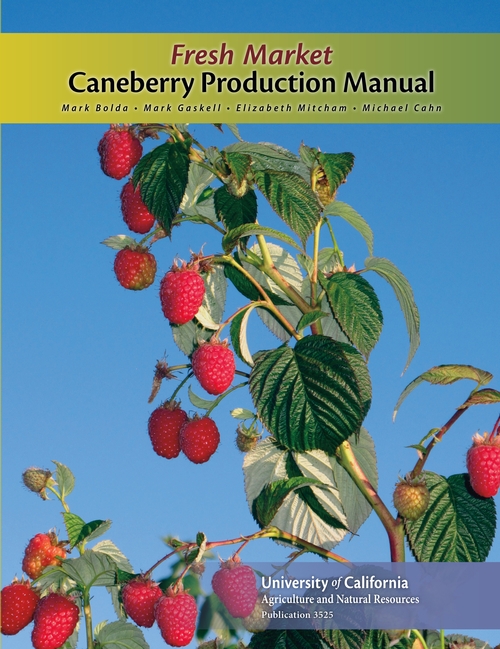
With more than 90 color photos, tables and illustrations and written by the UCCE experts in caneberries, the Fresh Market Caneberry Manual is the perfect field reference for growing blackberries and raspberries in California and the western United States.
Necrosis of Lateral Tips in Blackberry Caused by Botrytis.
The pictures below are of a farm call this morning concerning die back of laterals of maybe less than 1% of the total on blackberry. The symptoms occurred fairly evenly across the farm without regard to inside or outside of tunnels, organic or conventional.
As one can see from the second picture below, the die back does not advance that far down into the lateral, and since the apical dominance has been pushed down from the tip, often a new branch can be found at the lower limit of the necrosis. It certainly does not threaten the rest of the plant.
The key to understanding this situation was the presence of conidial masses on the outside of some of the dead tissue (Pictures 3 and 4 below), and also an observation by the attendant pest control adviser that plants are quite wet in the morning from guttation from the leaves. Lots of surface moisture + cool weather + soft, nitrogen rich tissue at the tip of the lateral = Botrytis problems.
Disease infection is very infrequent, the plant is rapidly maturing and the weather is warming so it is not expected that this disease will advance much further and no action is recommended. Hat tip to the grower and his pest control adviser on picking up on this.
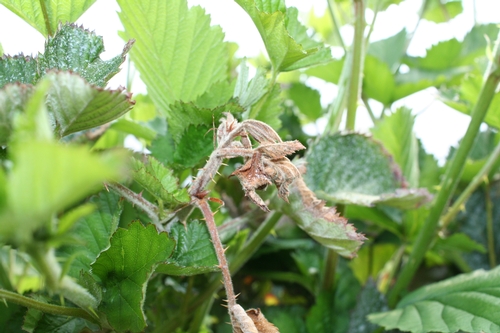
Dieback on blackberry lateral.
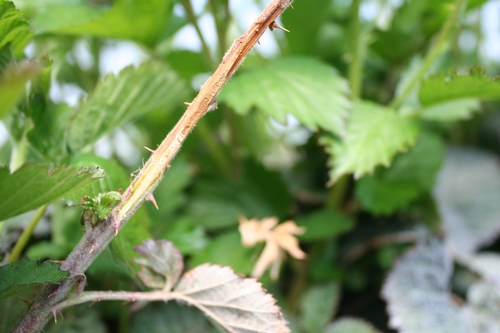
Not too great photo of dieback peeled down to core. Notice how dieback has advanced and apparently stopped. New lateral forming at lower edge.
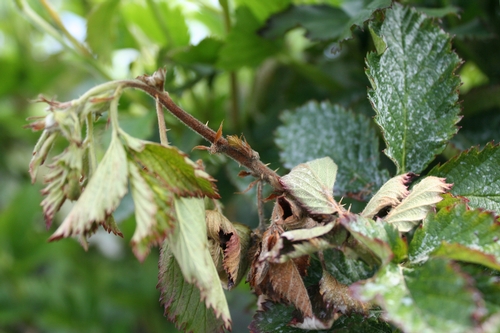
Photo of Botrytis conidial masses on outside of dead lateral tip.
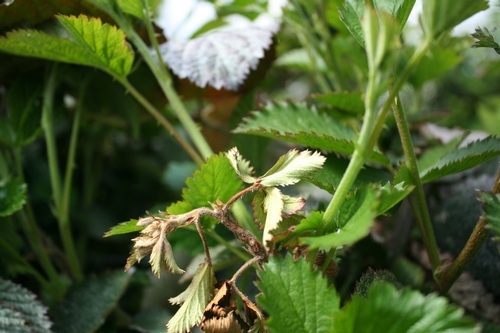
Conidial masses of Botrytis on the outside of a dead lateral tip.

